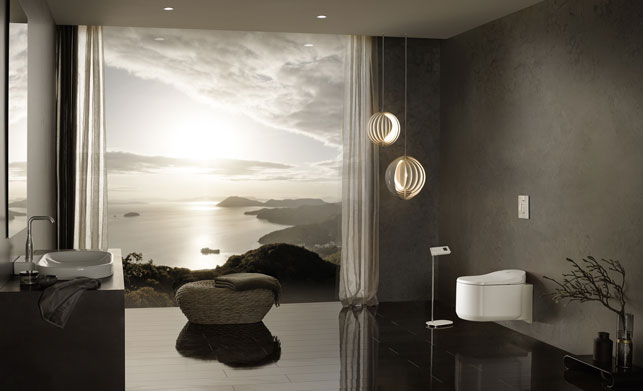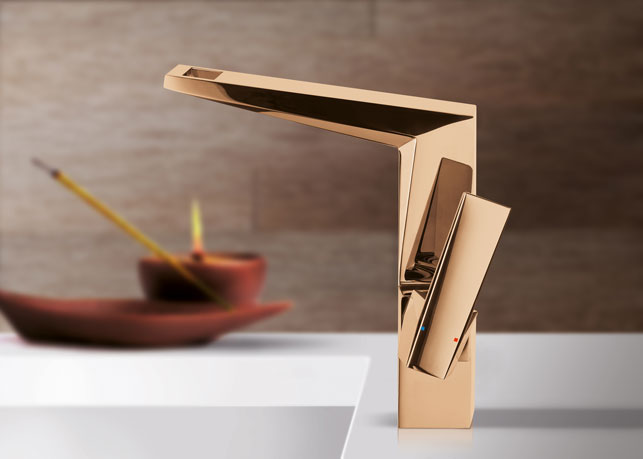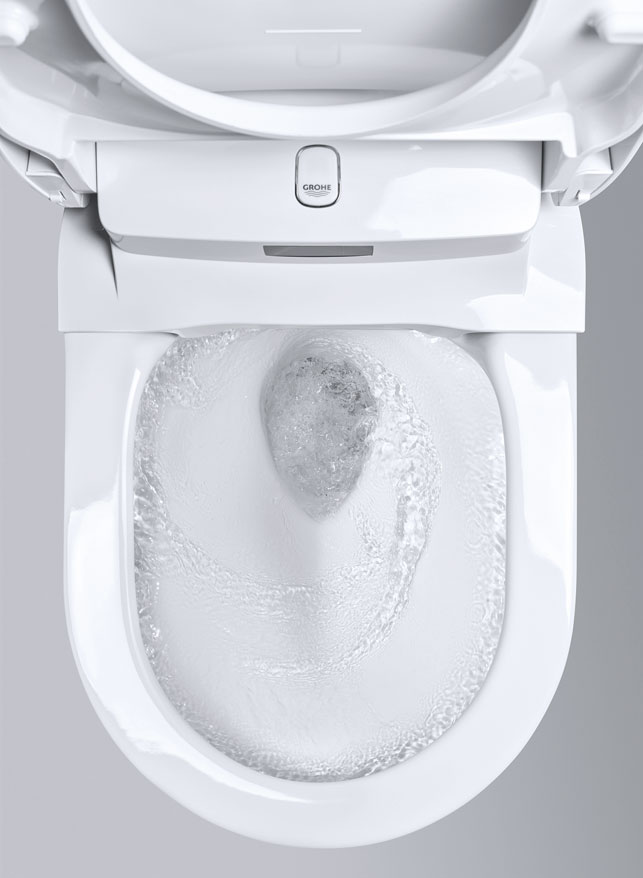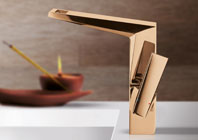Düsseldorf’s river port with its angular modernist buildings provides an appropriate backdrop to our conversation with Grohe – famed for its own combinations of water and sculpted metal.

The Grohe Sensia aims to change western toilet habits through use of good design and modern technology
The giant German bathroom and kitchen fittings company is one where design is as highly regarded as functionality when it comes to its products.
With a heavyweight list of design awards to its name, the company never rests on its laurels and is frank about its desire to move with the times, keeping ahead of consumer expectations.
“It’s an industry that’s ripe for innovation,” announces Grohe’s new VP of design Michael Seum. “Think about the amount of times you interact with just a faucet, the amount of touchpoints you have in the bathroom and the kitchen.” The American designer has taken up the design lead at the company, adding to its international design team dynamic at its Düsseldorf headquarters.
“That’s important as we look to grow in different markets, and gain different points of view, so we’re constantly driving dialogue around multicultural aspects when developing products.”

Grohe’s VP of design Michael Seum
Focus and guidelines
Regardless of the intended market, Grohe has set out its own distinctive look within its products, with three instantly recognisable design cues – the ring, the lozenge and the seven per cent angle bend – all used in a variety of ways, whether its tactile controls, aesthetic showerhead housings, or simple piping.
The core philosophy, Seum explains, is that its products are easy to use, human-centric in their form, and that they convey performance. This seems simple enough, but in a product range spanning hundreds of different bathroom faucets, shower fittings, kitchen mixer taps and now toilets it is a job that requires clear focus and guidelines to keep ahead of the curve.
“We want to be design risk takers: we don’t want to design for today; we want to design for tomorrow, so we’re always going to challenge the company to do the best by going forward.” To Seum, this means there’s a lot of potential for the sector to advance, and indicates how consumer expectations for experiences are changing.
“We have the fashion world coming into the home – high design brands now thinking about how consumers bring that lifestyle into their home – that has influenced how we think about opening the bedroom up to the bathroom, or even the kitchen to the living environment.
“These are now highly considered spaces for consumers, architects and designers, and it creates a new thought process within the design process.”
This consideration impacts Grohe’s design, where consumer expectations for attention to detail mean luxurious finishes and high quality.
“It’s no longer a functional product,” explains Seum. “It’s a really experiential, considered product.”

Bathrooms are much more considered spaces now, with consumers demanding more high-end finishes and design details
Design process
The design workflow at Grohe moves into CAD from the outset, beginning with sketches in Autodesk Alias.
“I have a philosophy that you need to get into CAD quickly,” states Seum. “CAD doesn’t lie, sketches can lie in terms of proportions, so we use Alias as a tool.
“There’s no better surfacing tool, and it can be a little bit time consuming for the team, but it guarantees that we have really great surfacing.”
The design team maintain control of all A-side surfaces throughout design and manufacture, with Grohe’s engineers not being allowed to change the aesthetics once released by the team, a factor Seum puts down to them being “almost obsessive about managing our data”.
To ensure the design intent of the products – especially when complex forms are needed – a member of the design team works closely with the engineering team to resolve any issues.
For the final 3D designs the team work in Siemens Solid Edge, with some designers comfortable enough with the software to skip sketching entirely to create designs directly in the CAD tool.
The CAD data allows for fast prototyping process at all stages, whether it’s a member of the team cutting a piece of foam just to get proportions right, 3D printing volume studies, or full aesthetic test pieces to be built in the factory. The 3D data from Solid Edge doesn’t just end with the physical products either; some of it moves on to help with visualisations for marketing and movies to aid installations.

A room previously only functional in purpose, bathrooms are now places consumers go for their own personal time and spainfluenced luxuries
Expanding the range
As Grohe moves forward its product range is expanding to include toilets based on its Japanese parent company Lixil’s e-bidet toilet platform.
These remote controlled, spritzing robotic bidets are uncommon outside of Japan, where the original idea arrived from Switzerland nearly 40 years ago. The bemusement of travellers visiting Japan, often left baffled by the lack of familiar toilet paper and faced with unnavigable control panels, is reflected only by the Japanese’s view of western toilet habits being outdated and unhygienic.
For Grohe the challenge was to transform the bathroom habits of consumers, taking the e-bidet ‘engine’ from Lixil’s bestselling Satis model and redesigning it for western tastes.
Away from the predominantly brass fittings the team normally design for, the new Sensia toilet added new challenges, such as the complexities of designing in ceramics – an area where they learned a great deal from sister companies American Standard and Inax.
Hygiene is a key factor, with a triple vortex flush and special ceramic coating helping rid the bowl of bacteria, self-cleaning bidet spray heads and antibacterial coatings throughout.
Additionally, the design of the Sensia’s electronic controls allowed for the inclusion of connectivity to mobile devices and the building of a clear user interface – stripping back the cluttered Japanese designs to a pared-back layout.
“It’s been a little bit of a challenge because the market expectations in Japan are completely different; they’ve had 40 years of experience with these technologies. We’ve had to take the technology and see how it would work for the European markets, or North American markets, for example. So we’ve tried to find the right amount of technology.”

The Sensia toilet bowl is a masterclass of function — a triple-vortex flush, non-stick coatings and anti-bacterial plastics
Creating synergy
The end product is a minimalist ceramic bowl, with a discreet control panel, that can instantly recall user wash preferences.
“This is what we call the ‘perfect personal synergy’ – so when you think about consumers, what they want is something that’s really, really personal and tailored to them. Not only great design, really human and approachable, but it’s fine tuned.”
While current Japanese products retail at around €4,500 the Grohe Sensia will cost around half that amount, still a high-end product, but one that has benefits beyond blasting your backside with the press of an app. With fast ageing populations that will struggle with traditional means of personal cleansing, and its connected ability to better manage water use, Grohe believes that the ‘shower toilet’ is the future.
Given our changing concepts of luxury, where health and wellbeing, along with experience and ease of use are increasingly valued in daily life, Grohe feels that the North European markets will be among the first to adopt the product – although it admits the key battle will be changing bathroom habits that are over 400 years old.
Yet, with the speed that our lives and homes have changed in the past decades it’s hard to imagine that the humble toilet will be left behind.
grohe.com
Grohe – where unmatched style meets perfect function in the bathroom
Default






